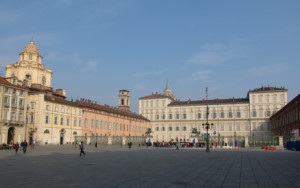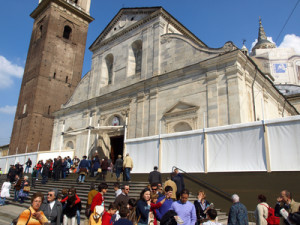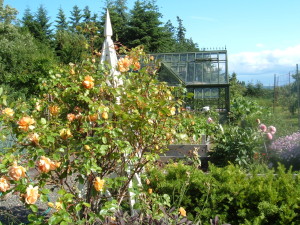This blog will take you to places you’ve always wanted to see and to some you may only have heard of. Its purpose – to immerse you in extraordinary tastes and colors, smells, sights and experiences, infecting you, or perhaps aggravating, an already serious case of wanderlust.
Many thanks for visiting Foreign Writes. Your comments are always welcome. Hope you’ll be back soon!
To view comments or to leave one, please click on the title of the post. Click on photos to enlarge.
Italy – Panic in Torino
It’s a relief to roll into Turin. I check into the centrally located youth hostel and set off to see the sights. The town is bustling. It has doubled in size since the end of the war as Southern Italians flood into Italy’s Detroit looking for work at Fiat, Alfa Romeo and Lancia. They are part of the Italian Economic Miracle – transforming the country from poor and rural to wealthy and urban.
Torino’s grand piazzas were mostly built from the 16th to the 18th centuries
under the Dukes of Savoy who controlled this neighborhood and became Italy’s royal family at unification in 1861 – the first time the peninsula had been united since Roman times.
The House of Savoy was responsible for establishing a final resting place for its most famous possession – The
Shroud of Turin. Tradition says it was brought from Constantinople by a French knight in 1349. Inherited by the Savoys, they eventually brought it to Turin in 1578. It’s been in the Cathedral of St. John the Baptist in the Guarini chapel since 1694.
The shroud shows the image of a man who appears to have suffered the physical trauma of a crucifixion. (Its authenticity is still being debated and if you want to know 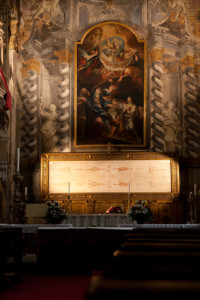 more, the shroud has its own website – www.shroud.com – that goes into all the details.)
more, the shroud has its own website – www.shroud.com – that goes into all the details.)
Whatever it is, it is very impressive and I am lucky enough to be there when it is on display.
I decide to treat myself to a coffee in one of Turin’s atmospheric cafes, and reach inside my bag for my wallet. It’s not there! I paw through the bag in total panic. My first day in Italy, and I’ve been robbed! All the money I have for the summer is in that wallet. I fight tears as I sprint back to the youth hostel and tear apart the backpack I left lying on my bed in the dormitory.
My wallet is there – and nothing is missing. My very own miracle! The elation of a saved summer has me floating.
There is still the matter of finding someone to hitchhike with me to Genoa. At dinner in the hostel dining room I find a candidate. I’m good to go!
Next: Genoa and Decision Time
Happy Valentine’s Day!
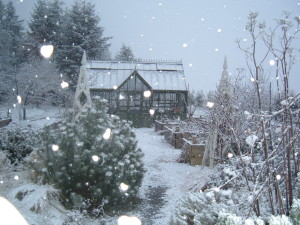 News of ice storms, snow, frigid temperatures, power outages – record breaking, apocalyptic, devastating. This year the Northwest has been spared – so far.
News of ice storms, snow, frigid temperatures, power outages – record breaking, apocalyptic, devastating. This year the Northwest has been spared – so far.
Still, when the forecast is for days and days of rain, who doesn’t long for summer?
Besides, it’s Valentine’s Day, and you should have a bouquet. So, close your eyes and conjure up memories of the sun on your shoulders, teasing out the cold in your bones. The birds and bees are busy doing their thing and perfume from a dozen varieties of roses in full bloom wafts your way.
Some are very ancient, like Mutabilis.
Some are recently bred by David Austin in England, though they mimic old- fashioned blooms with hundreds of tightly packed petals. He gives them wonderful names. My favorite is Jude the Obscure, a rounded creamy apricot ball of petals with an indescribable perfume. But then there’s also Heritage, a pale pink, whose perfume is nearly as sweet. And Pat Austin, named after David’s wife, is perfect for smothering an obelisk. The color of apricot/pink Sharifa Asma makes you stop in your tracks.
And who would want to be without the simple beauty of Lyda Rose?
But my all time favorite is Westerland – covered for most of the summer with over-the-top blooms of gold and orange, a deep purple clematis growing through it. The two have climbed to our second floor porch and are aiming for the roof.
Westerlund’s cousin, Autumn Sunset, is nearly as fabulous.
So take a deep breath and raise a glass to SUMMER! It’s worth waiting for. Happy Valentine’s Day.
NEXT: Panic in Torino
Goodbye France – Hello Italy
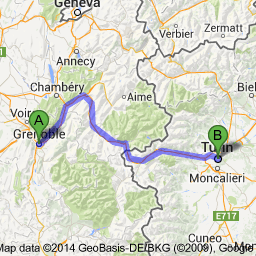 June and end-of-year exams – a translation, a composition and the oral judged on grammar, pronunciation and conversation. Yea! I pass with the equivalent of a B+. I even get a diploma. Then it’s time to say goodbye. That is hard. Our little band has grown close and none of us can believe our year together is about to end. There’s no time for mourning, though, as I’m leaving for Italy with Anne from London in her aged Deux Chevaux – two horses- two cylinders, that’s all the power this baby’s got.
June and end-of-year exams – a translation, a composition and the oral judged on grammar, pronunciation and conversation. Yea! I pass with the equivalent of a B+. I even get a diploma. Then it’s time to say goodbye. That is hard. Our little band has grown close and none of us can believe our year together is about to end. There’s no time for mourning, though, as I’m leaving for Italy with Anne from London in her aged Deux Chevaux – two horses- two cylinders, that’s all the power this baby’s got.
Citroen’s Deux Chevaux, developed in great secrecy, was meant to be introduced at the 1939 Paris Auto Show, but France  declared war on Germany in September. No more auto show. Citroen managers secretly hid or destroyed the existing models of the Deux Chevaux because they feared such a vehicle would be too useful to the Germans. Some of the little cars were even buried
declared war on Germany in September. No more auto show. Citroen managers secretly hid or destroyed the existing models of the Deux Chevaux because they feared such a vehicle would be too useful to the Germans. Some of the little cars were even buried
The Deux Chevaux is finally introduced in 1948 as the affordable car for a largely rural France. It is designed to hold three small farmers, with suspension good enough to transport a cargo of eggs across a plowed field without breakage. Because it’s so light, it gets 78 miles per gallon in precious post-war fuel. Additional features are its canvas roof and hammock seats suspended from metal tubing. It’s called the umbrella on wheels.
Anne offers to take me as far as Turin – after that I’m flying blind. There is no way I can afford a train, so my prayer is that I’ll find someone in Turin to hitchhike with. I’m feeling flush with 50 cents a day for youth hostel accommodations and $1.00 for everything else.
It’s foggy when leave early on a June morning, and the fog only gets denser as we climb. We’re crawling across the Alps and Anne’s aged little car is not happy.
 By the time we reach the snow line, I’m having doubts about making it to Turin. The road gets steeper and finally the Deux Chevaux comes to a complete stop. When Anne takes her foot off the brake and steps on the accelerator, we go backward instead of forward. This is scary. I get out and push, joined by good Samaritans in the two cars behind us. It’s just enough to make it over the final pass. Weak with relief, we coast into Turino.
By the time we reach the snow line, I’m having doubts about making it to Turin. The road gets steeper and finally the Deux Chevaux comes to a complete stop. When Anne takes her foot off the brake and steps on the accelerator, we go backward instead of forward. This is scary. I get out and push, joined by good Samaritans in the two cars behind us. It’s just enough to make it over the final pass. Weak with relief, we coast into Turino.
I will see Italy after all!
By the way, if you make that trip today there are a couple of tunnels that make it a lot easier – even for a Deux Chevaux. If your stomach is up to it, have a look on Youtube at ‘Grenoble to Torino ALPS passage in 7 minutes’.
France – Crazy in Spain
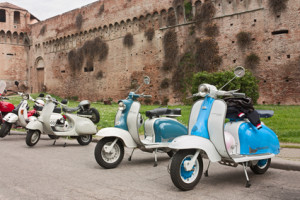 Spain beckons as Easter break nears, but budgets are tight and memories of the persistent truck drivers from our last trip make hitchhiking less than appealing. The lightbulb goes on when Judy from Newark spots an ad for a 10-year-old Lambretta motor scooter on the AGE bulletin board. Neither of us has ever driven one, but we try it out in a large parking lot and I only tip over once. Its owner extolls the pleasures of scooter travel and Judy, the more experienced driver by far , convinces me I’ll get the hang of it. The price is right. We pool our funds and take the plunge. Wheels! We name it George.
Spain beckons as Easter break nears, but budgets are tight and memories of the persistent truck drivers from our last trip make hitchhiking less than appealing. The lightbulb goes on when Judy from Newark spots an ad for a 10-year-old Lambretta motor scooter on the AGE bulletin board. Neither of us has ever driven one, but we try it out in a large parking lot and I only tip over once. Its owner extolls the pleasures of scooter travel and Judy, the more experienced driver by far , convinces me I’ll get the hang of it. The price is right. We pool our funds and take the plunge. Wheels! We name it George.
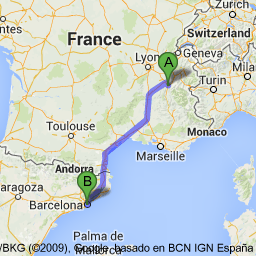 Two weeks. We want to squeeze in Barcelona and Madrid, but it will be tight. On the map it looks daunting – over 300 miles to Barcelona and about the same from Barcelona to Madrid. We set off, sans helmets, side compartments stuffed with essentials, Judy driving. The weather is good as we head south, exhilarated by the freedom of our new wheels. We spend the night on the French coast, and shortly after noon the next day cross into Spain!
Two weeks. We want to squeeze in Barcelona and Madrid, but it will be tight. On the map it looks daunting – over 300 miles to Barcelona and about the same from Barcelona to Madrid. We set off, sans helmets, side compartments stuffed with essentials, Judy driving. The weather is good as we head south, exhilarated by the freedom of our new wheels. We spend the night on the French coast, and shortly after noon the next day cross into Spain!
We follow the coast road through the Eastern Pyrenees. The views are  spectacular as we climb through villages and up steep inclines overlooking the dazzling blue of the Med.
spectacular as we climb through villages and up steep inclines overlooking the dazzling blue of the Med.
As we leave one of these villages our back tire goes flat. We push the Lambretta back to a cafe and are directed to a mechanic not too far away. By the time the tire is fixed it’s too late to go further, so we find a cheap room. The owner of the cafe is friendly and we eat well – bread smeared with olive oil. garlic and tomato sauce, and local sausages. The wine is good too.
We make it to Barcelona the next day with no further mishaps. It’s a lovely city of broad boulevards, but by far the most amazing sites are the buildings by Antoni Gaudi. We’ve never seen anything like them and are stunned at our first sight of the unfinished church of the Sagrada Familia. Begun in 1883, it’s the most ambitious and famous of Gaudi’s works. (Funded privately, estimates are that it will be completed in 2027.) We wonder at the mind that envisaged the free form shapes and spires that take your breath away.
Even more playful are buildings like the Casa Batllo. 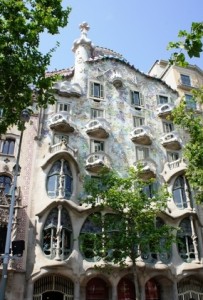
Dr. Seuss characters would feel right at home.
 The Parc Guell is even more extravagant, with wild mosaic tiles, and shapes children of all ages would find irresistible.
The Parc Guell is even more extravagant, with wild mosaic tiles, and shapes children of all ages would find irresistible.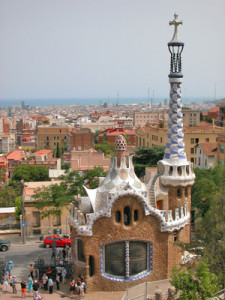
Reluctantly we leave Barcelona and head for Madrid, taking the busy main highway to save time. We’re very lucky the traffic is light, because our rear tire blows. The only injury is my dislocated thumb, swelling fast and pretty painful. We find a garage that can fix the tire and a doctor who assures me there are no bones broken. He gives my thumb a jerk to put it back in place and adds a splint and bandage. It’s obvious I won’t be driving the scooter. So much for Madrid, but we’re not that disappointed – just as glad not to put another 600 miles on George.
Instead we cross our fingers that the tires will hold, and head North following the winding interior mountain road that will  take us over the Pyrenees. More stunning scenery. At the mountain hotel where we spend the night, the owners cook us dinner and then serenade us with Catalan music.
take us over the Pyrenees. More stunning scenery. At the mountain hotel where we spend the night, the owners cook us dinner and then serenade us with Catalan music.
Though all the people we meet are friendly and always willing to help, they shake their heads when they learn we’ve come from Grenoble, and make it clear, despite the language barrier, that they think the two Americanas on the motor scooter are crazy. They could be right.
France – Carnival in Nice
February. The days are cold and there’s snow on the ground. Talk is of Carnival in Nice – of doffing winter clothes, breathing in the Mediterranean, soaking up the sun – and partying. Judy from Newark and I have some plotting to do. (Pat from Philadelphia left after the first semester.) Hitchhiking worked pretty well during our Christmas adventure, so. . . .
We plan on a week trip and a minimal budget – a day of travel each way (if we’re lucky) and 4-5 days in Nice culminating in Mardi Gras – Fat Tuesday – climax of the two-week celebration. Nice hosts the oldest celebration of Carnival – dating from the 1300s. It changed from a private event of costumed balls to a public celebration, including parades, in the 1800s. Now it draws hundreds of thousands of visitors tired of winter and ready to let loose in keeping with traditional carnival excess. It’s name comes from the words carn levare – put away the meat – and it’s a final indulgence before the strictures of Lent.
Our trip to Nice takes most of a day. We thread our way through the snowy mountain passes that surround Grenoble, heading South with a variety of friendly and non-threatening rides. 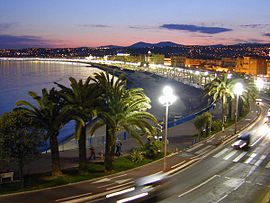 My first glimpse of the Mediterranean – and palm trees – is a thrill as we travel along the coast road through Cannes. The air is soft, the fragrances too. We are on the Riviera and we luxuriate in its warmth.
My first glimpse of the Mediterranean – and palm trees – is a thrill as we travel along the coast road through Cannes. The air is soft, the fragrances too. We are on the Riviera and we luxuriate in its warmth.
Nice is packed. Somehow we find a cheap room in an off-the-beaten track hotel. We dump our backpacks and head for the Promenade des Anglais – the walkway along the Baie des Anges (Bay of Angels) that is Nice’s waterfront. We breath in the perfume of the sea and lift faces to the sun. This is what we came for.
 The parades follow the Promenade des Anglais and culminate in the Bataille des Fleurs (Battle of the flowers) and the Mardi Gras blowout. The ‘battle’ is one-way and pretty tame, with gorgeous, scantily clad girls throwing flowers into the crowd. Lots of the parade floats feature giant heads made of paper mache, many are caricatures of politicians.
The parades follow the Promenade des Anglais and culminate in the Bataille des Fleurs (Battle of the flowers) and the Mardi Gras blowout. The ‘battle’ is one-way and pretty tame, with gorgeous, scantily clad girls throwing flowers into the crowd. Lots of the parade floats feature giant heads made of paper mache, many are caricatures of politicians.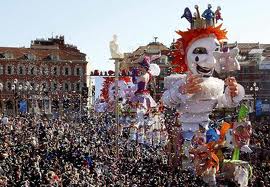
Though Nice is packed the crowds are happy and very friendly. While getting a bite at a cafe, a group of four medical students from Spain joins us. They are very cute and more than happy to practice their English. They walk us back to our hotel and, over my protests, Judy invites them up. (Judy is never one to think too far ahead.) Not surprisingly, they assume this as an invitation to get to know us better, and it’s only after considerable effort that we herd them out the door. They are in good humor and so are we. It’s a Carnival encounter.
 The parades are over-the-top spectacular and meet all expectations. The costumes, music, confetti and tossed flowers have the crowd, including us, dancing.
The parades are over-the-top spectacular and meet all expectations. The costumes, music, confetti and tossed flowers have the crowd, including us, dancing.
And then it is time to head back to Grenoble.
It takes a while, but not far outside Nice we are picked up by two trucks headed North. We gratefully climb in – one of us per truck. Their route through the mountains is slow and they announce that we will stop for the night at a small mountain hotel. Judy and I have dinner and retire to our room. Shortly, there is a knocking and then a banging on the door – our truckers – who become more and more upset when we do not open it. The banging goes on for quite a while. When we go down to breakfast the next morning we are relieved to find that they have left.
The trucker experience gives us pause. Given our budgets, can we come up with better transportation options for our next adventure?


